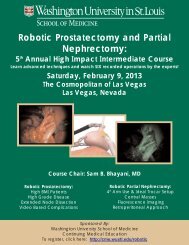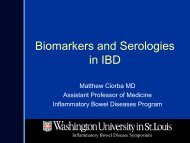Surgical Management of Crohn's Disease - cme
Surgical Management of Crohn's Disease - cme
Surgical Management of Crohn's Disease - cme
- No tags were found...
You also want an ePaper? Increase the reach of your titles
YUMPU automatically turns print PDFs into web optimized ePapers that Google loves.
PhenotypesInflammatory Stricturing PenetratingPainTendernessDiarrheaWeight LossCrampsDistensionVomitingDiarrheaPainFeces and air in urineEnterocutaneousEnteroentericEnterovesical/vaginalRetroperitoneal
Indications for surgery• PerforationAbsolute• Intractable Hemorrhage• Persistent Obstruction• Dysplasia or cancer• Unresponsive fulminantdiseaseRelative• Refractory disease• Side effects <strong>of</strong> medication(steroid dependence)• Chronic or recurrent obstruction• Fistula• Abscess not amenable topercutaneous drainage
Goals <strong>of</strong> surgical management• Palliative• Early surgical consultation• Good communication with GI and patient essential• Establish goals and inform patient <strong>of</strong> expectations• Optimize nutritional status• Obtain “roadmap”– CT, colonoscopy, SBS
<strong>Surgical</strong> decision making• Timing <strong>of</strong> surgery• Preoperative infection control• Resection margins• Anastomotic technique• Strictureplasty versus resection• Laparoscopic versus open surgery• Segmental versus total colectomy• Perioperative CD medications
<strong>Surgical</strong> decision making• Timing <strong>of</strong> surgery• Preoperative infection control• Resection margins• Anastomotic technique• Strictureplasty versus resection• Laparoscopic versus open surgery• Segmental versus total colectomy• Perioperative CD medications
Surgery in the biologics era
Perforating <strong>Crohn's</strong> ileitis: delay <strong>of</strong> surgery isassociated with inferior postoperative outcome197 patients underwent 231 bowel resections for perforating ileitis(1992 – 2009). Duration <strong>of</strong> clinical deterioration prior to surgerydetermined.• If the patient was sick for >5 months:• Greater number <strong>of</strong> structures in the inflammatory mass (3.3 vs 2.8)• Higher probability <strong>of</strong> taking immunosuppressive drugs (26% vs 14%),budesonide (29% vs 14%), and a multiple-drug combination (31% vs 16%)at the time <strong>of</strong> surgery• Higher incidence <strong>of</strong> post-op septic complications (31% vs 13%)Retrospective study – but, the suggestion is that earlier operationmay mean better outcomesIesalnieks et al Inflamm Bowel Dis 2010
Timing <strong>of</strong> surgery• Timing is critical– For some patients, waiting leads to worseoutcome.– On the other hand, delaying surgery isbeneficial for many patients and in somecases may avoid surgery altogether.
<strong>Surgical</strong> decision making• Timing <strong>of</strong> surgery• Preoperative infection control• Resection margins• Anastomotic technique• Strictureplasty versus resection• Laparoscopic versus open surgery• Segmental versus total colectomy• Perioperative CD medications
Preoperative control <strong>of</strong> sepsis• For a contained,CD-related intraabdominalabscess,percutaneousdrainage issuccessful in 96% <strong>of</strong>cases.• 50% <strong>of</strong> thesepatients willeventually requiresurgery.
Intraabdominal abscessInfluence <strong>of</strong> percutaneous abscess drainage on severepostoperative septic complications in patients withCrohn’s disease25 patients with CD and spontaneous intra-abd abscess whounderwent intestinal resection. Preop IR drainage performed in12/25 patients (avg <strong>of</strong> 37 days prior to surgery).Post op intra-abd complication (leak, abscess)– 3/12 (25%) with preop drainage– 9/13 (69%) without preop drainage– p=0.04
<strong>Surgical</strong> decision making• Indications for and timing <strong>of</strong> surgery• Preoperative infection control• Resection margins• Strictureplasty versus resection• Segmental versus total colectomy• Anastomotic technique• Laparoscopic versus open surgery• Nutritional status• Perioperative CD medications
Effect <strong>of</strong> resection margins on the recurrence <strong>of</strong>Crohn’s disease in the small bowel• 131 patients randomized to 2cm vs 12 cm margin fromgrossly involved bowel.• Median f/u = 55.7 monthsRecurrence = operation for preanastomoticdisease• Recurrence rates– Limited resection = 25%– Extended resection = 18%– p=NS• Results – no differences in earlypost-op complications
<strong>Surgical</strong> decision making• Timing <strong>of</strong> surgery• Preoperative infection control• Resection margins• Anastomotic technique• Strictureplasty versus resection• Laparoscopic versus open surgery• Segmental versus total colectomy• Perioperative CD medications
Anastomotic technique• Stapled versus handsewn• 7 trials, 1125 patients (441 stapled,684 handsewn)• Stapled anastomoses associated withsignificantly fewer leaks than handsewn• No difference in other outcomes(stricture, time, bleeding, reoperation,mortality, LOS, abscess, woundinfection)• Side to side versus end to end• Multicenter, RCT• 139 patients per group, 1 yr followup• No difference in endoscopic (40%) orsymptomatic (20%) recurrence rate
<strong>Surgical</strong> decision making• Timing <strong>of</strong> surgery• Preoperative infection control• Resection margins• Anastomotic technique• Strictureplasty versus resection• Laparoscopic versus open surgery• Segmental versus total colectomy• Perioperative CD medications
Strictureplasty• First described in 1979• Adopted from treatment<strong>of</strong> tuberculous strictures• Multiple series havedocumented thatperioperativecomplications are samefor strictureplasty andresection
Strictureplasty• Indications– Diffuse involvement<strong>of</strong> bowel withmultiple, remotestrictures– Patients who haveundergone majorprevious intestinalresection– Short, fibroticstrictures• Contraindications– Index operation– Multiple strictureswithin a shortsegment or close toa site <strong>of</strong> resection– Local sepsis(phlegmon,perforation)– Hypoalbuminemia– Suspicion <strong>of</strong> cancer
Surgery for Crohn’s <strong>Disease</strong>: StrictureplastyAn alternative to resection in “stenosing”disease• 698 strictureplasties in 162patients• Cumulative 5 year reoperativerecurrence = 28%• Re-stricture at previousstrictureplasty site = 5%• Most re-operationsperformed for new sites <strong>of</strong>disease
• Finding intestinal strictures at surgery
<strong>Surgical</strong> decision making• Timing <strong>of</strong> surgery• Preoperative infection control• Resection margins• Anastomotic technique• Strictureplasty versus resection• Laparoscopic versus open surgery• Segmental versus total colectomy• Perioperative CD medications
Laparoscopic surgery• Clearly improves– Body image– Cosmesis– Self-confidence• Meta-analysis– Longer OR times– Significant short termbenefits:• Return <strong>of</strong> bowel function• Resuming oral intake• Length <strong>of</strong> stay• Morbidity• Hospital cost– No difference in recurrence
Laparoscopic surgery• Cochrane DatabaseReview 2011– Included 2 RCTs on lapvs. open surgery forsmall bowel CD– No significant differencein perioperativeoutcomes or long-termreoperation rates fordisease or non-diseaserelated complications <strong>of</strong>CD
<strong>Surgical</strong> decision making• Timing <strong>of</strong> surgery• Preoperative infection control• Resection margins• Anastomotic technique• Strictureplasty versus resection• Laparoscopic versus open surgery• Segmental versus total colectomy• Perioperative CD medications
Crohn’s colitis• <strong>Disease</strong> patterns dictate resection– Pancolitis with proctitis TPC w ileostomy– Pancolitis no proctitis TAC w IRA– Proctosigmoiditis or APR or TPCsevere perianal disease– Segmental colitis Segmentalcolectomy orTAC/IRA
Crohn’s colitis• Meta-analysis <strong>of</strong>segmental vs.subtotal colectomy– No difference insurgical recurrence,overall recurrence,postop complicationsor incidence <strong>of</strong>stoma formation– Faster time tosurgical recurrencein segmental group• Conclusions– Segmentalcolectomy isappropriate in ahighly select group <strong>of</strong>patients• Truly segmental• Rectal sparing• No TI disease• No Perianal disease• Good sphincter tone• Distensible rectum
<strong>Surgical</strong> decision making• Timing <strong>of</strong> surgery• Preoperative infection control• Resection margins• Anastomotic technique• Strictureplasty versus resection• Laparoscopic versus open surgery• Segmental versus total colectomy• Perioperative CD medications
The surgeon’s viewpoint• If it goes well: I am a brilliant surgeon…• If it goes wrong: It’s because <strong>of</strong> thosedamned drugs that were prescribed bythe gastroenterologists…
SteroidsTotal complicationsSeptic complicationsOR 1.41, 95% CI 1.07-1.87 OR 1.68, 95% CI 1.24-2.28
Steroids – Dose matters
Biologics
Perioperative treatment with infliximab in patientswith <strong>Crohn's</strong> disease and ulcerative colitis is notassociated with an increased rate <strong>of</strong> postoperativecomplications413 consecutive IBD patients, 188 (45.5%) with CD.24.5% had received preoperative IFX < or = 12 weeks beforesurgery.• Results: No differences in anastomotic leak (3.0% vs. 2.9%),infections (5.97% vs. 10.1%), thrombotic events (3.6% vs.3.0%), prolonged ileus/SBO (3.9% vs. 2.8%), cardiac (1% vs.0.6%), and hepatic/renal complications (1.0 vs. 0.6%).• CONCLUSIONS: Preoperative IFX was not associated with anincreased rate <strong>of</strong> cumulative postop complications.
Summary• Surgery for CD is palliative.• Optimize nutritional status.• Set clear goals <strong>of</strong> therapy and communicate withpatient and gastroenterologist.• Conservative intestinal resection is important.• Laparoscopic approach is preferred.• Steroids but not biologics influence postoperativeoutcomes.






